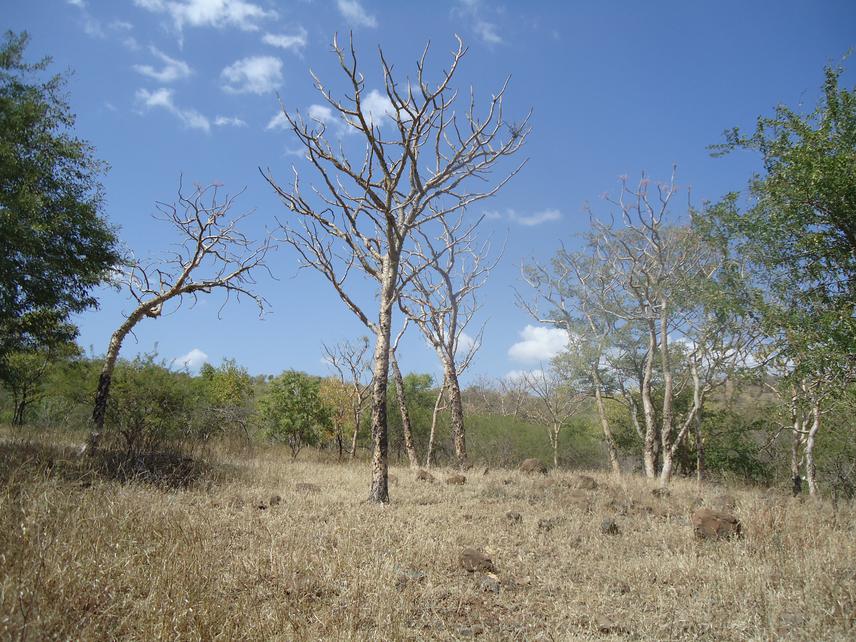Article featuring the project.
Journal for Nature Conservation, Volume 76, December 2023, 126506
1 Jun 2023 Abergelle, Ethiopia, Africa Forests | Communities | Biodiversity | Habitats
Prioritizing the Factors Affecting Conservation of the Endangered Boswellia papyrifera Tree Species, and Developing its Community-Based Solutions in Ethiopia
Empowering Community to Introduce Area Enclosure for Enhancing Natural Regeneration of the Endangered Boswellia Papyrifera and its Degraded Habitat in Ethiopia
Local Stakeholders-Based Interventions for Sustainable Conservation and Restoration of the Endangered Boswellia papyrifera and its Degraded Habitats in Ethiopia
Background:
The endangered Boswellia papyrifera is a multipurpose tree species across East African region. Particularly in Ethiopia, it covers about 1.5M ha, and offers substantial economic, ecologic and socio-cultural values (Bongers et al., 2019). For example, in 2014, Ethiopia exported nearly a million tonnes of the tree's frankincense resin with a worth of US$10M (Tadesse et al., 2020). Despite the species wide range of benefits, it is currently heavily threatened by overexploitation (e.g., frankincense collection by the local community) and habitat degradation (Tesfay et al., 2020). Consequently, it was listed as endangered tree species by the TRAFFIC and was recently suggested to be considered for a vulnerable category in the IUCN Red List (Bongers et al., 2019).
We have been closely working with local and nation stakeholders on conservation of B. papyrifera woodlands in Ethiopia since 2017. For example, through our previous three RSG projects introduced various interventions (e.g., capacity building, habitat restoration techniques). These interventions helped to improve in some extent the conservation of the species (Tesfay et al., 2020). They also prioritized some alternative interventions for its future conservation. Supporting the local woman (to gradually replace their intensive frankincense collection) through the available alternative livelihoods was suggested as a top priority intervention. This project will then focus on the introduction of the alternative livelihoods, with the following objectives:
1. Provide capacity building training to the selected local women on the alternative livelihoods (e.g., poultry, beekeeping and home-gardens)
2. Improve livelihoods of the selected local women through the alternative livelihoods by providing start-up inputs (chicken, beehive and seeds), and continuous technical support
3. Develop a comprehensive manual of the project, and handover it to the local stakeholders
4. Share results of the project with the relevant stakeholders through workshops
5. Link the supported local women with our well-established partners for their sustainable support
6. Disseminate results of the project through different printed and e-sources media outlets

Over-tapped Boswellia papyrifera stands in the Abergelle District, Tigray, northern Ethiopia.
Methods:
As continuation of our previous RSGs projects, this project will be implemented at the Abergelle district, Tigray region, northern Ethiopia. Before starting of the project, we will hold a meeting with the local stakeholders of the district (local community, rangers, local experts and NGOs) to discuss on importance of the project and to receive their feedback. The local stakeholders will then be given a chance to select their four representatives (one from each stakeholder group mentioned above) to join the project team members.
The representatives will then jointly work with us to achieve the project activities. Jointly with the representatives, we will select 50 local women, whose subsistence income highly dependent on frankincense resin of the species. We will then practically train the women on the alternative livelihoods (poultry, beekeeping and home-gardens) as to improve their income. We will also provide them start-up inputs (chicken, beehive and seeds) and continuous technical support to start their farming activities properly. Furthermore, we will collect data on roles of the introduced livelihood interventions for conservation of the species. These data will be combined with our previous RSG data to develop a comprehensive manual of the project. The manual will then be given to the local stakeholders and shared with the relevant stakeholders via workshops. Additionally, we will disseminate results of the project through printed and e-sources media outlets for raising awareness locally, nationally and globally on conservation of the species.
Expected outputs:
1. Improved capacity and skills of the local women on the chosen alternative livelihoods
2. Improved and diversified livelihoods of the selected local women through production of new products (eggs, honey, vegetables) from their alternative livelihoods
3. Developed a comprehensive manual for sustainable conservation of the species
4. Increased the number of local and national partners to be linked with our project activities
5. Raised awareness locally, nationally and globally on conservation of the species
6. Documented results of the project through different outputs like manual, printed (e.g., newsletters) and e-sources (e.g., websites, Research-Gate)
Header: Scattered Boswellia papyrifera stands during dry season in the Abergelle District, Tigray, northern Ethiopia.
Article featuring the project.
Journal for Nature Conservation, Volume 76, December 2023, 126506
Article featuring the project.
Fencing improves the establishment and growth of Boswellia papyrifera (Del.) Hochst wildlings
Articles featuring the project.
Article featuring the project.
Yield and chemical composition of frankincense from Boswellia papyrifera cutting-based planted trees